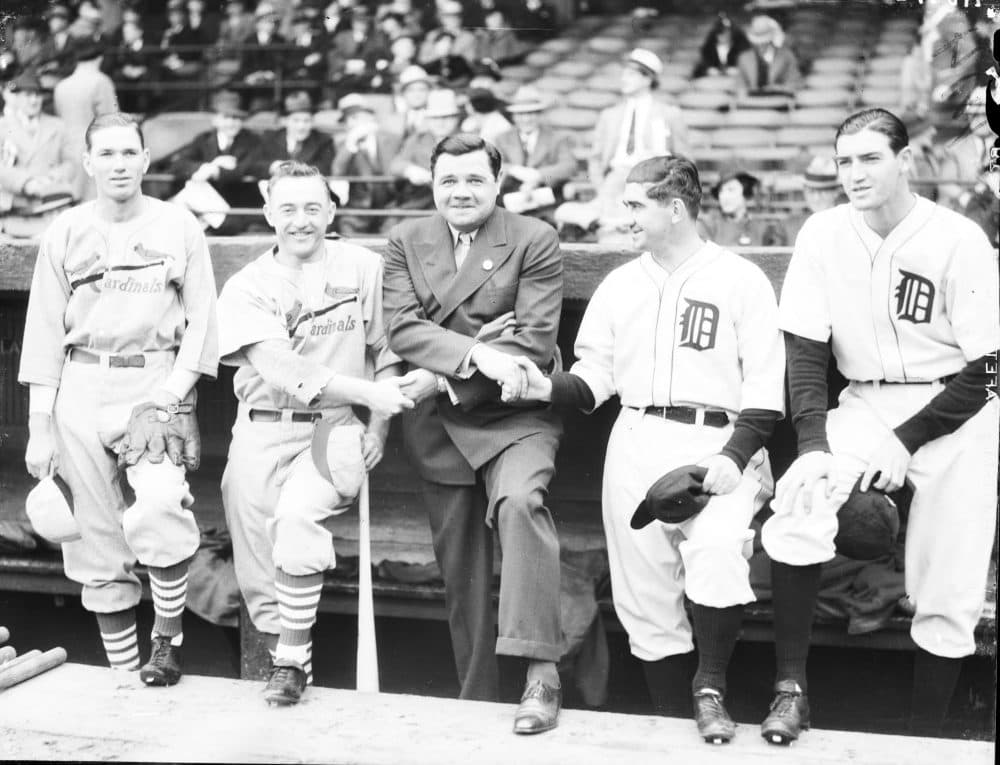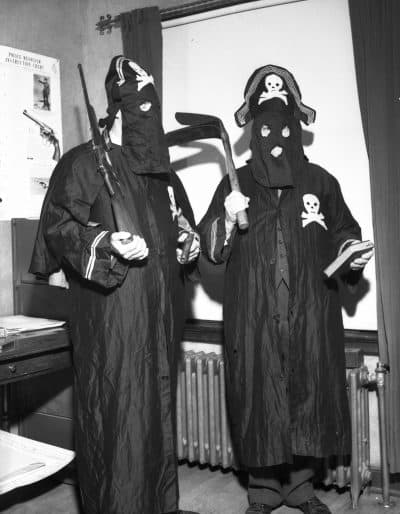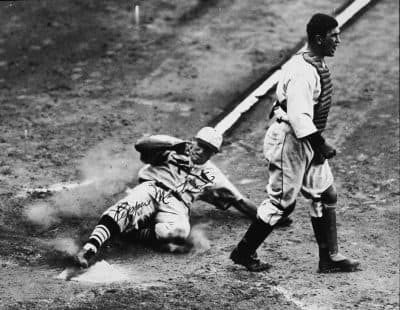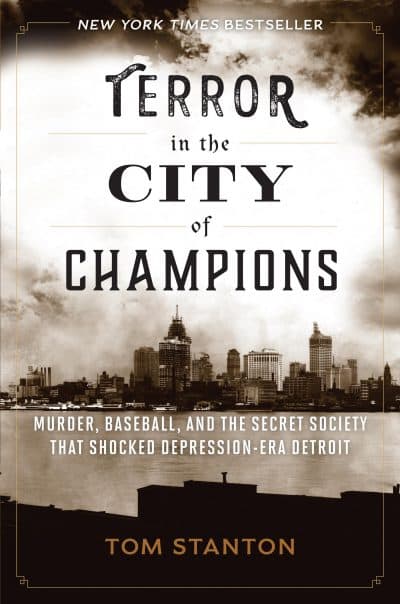Advertisement
The Secret Society That Terrorized Detroit During The City's Greatest Sports Era
Resume
There were reasons to feel very good about Detroit in the mid-1930s. One of them, according to historian and author Tom Stanton, was the Tigers.
"They won the World Series in 1935," Stanton says.
Then there were the Red Wings.
"They also won the Stanley Cup," he continues.
… and the Lions.
"They won the NFL title," he adds.
… and the greatest boxer of his time, a fellow who grew up in Detroit.
"Joe Louis was the uncrowned, undefeated heavyweight champion," Stanton says.
So in Detroit it was the best of times, right? No other city could boast such a simultaneous embarrassment of riches in the realm of sports. And a good thing, too. Because if ever a city needed diversions from the day-to-day routine in which its citizens were involved, it was Detroit in the mid-30s.
"The market crashed in ’29, and, by ’33, Detroit had an unemployment rate of 40 percent. So it was a tumultuous time," Stanton says. "You had all these folks who had come from other countries, other parts of the country, struggling to survive. Folks who had come from the South and folks who were Catholic and had come from Italy and elsewhere — and all of them struggling to keep jobs. And one way you could keep a job, if you were in a factory, was to belong to the Black Legion. And many folks did."
The Secret Organization Terrorizing Detroit
Perhaps you’ve never heard of the Black Legion. Lots of folks haven’t, and some who have, well, they’ve found it convenient to forget what they knew.

"But in its time, it was a huge deal," Stanton says. "There were a couple of movies that came out, one starring Humphrey Bogart, called the 'Black Legion.'"
The Black Legion, which Stanton describes as a more violent version of the Ku Klux Klan, was a secret organization dedicated to terrorizing minorities, particularly blacks, Catholics and Jews. The Black Legion had as many as 100,000 members across four states.
The Black Legion’s popularity in Detroit coincided with the city’s greatest sports era. And how people handled that circumstance illustrates the irrational ways in which fans sometimes behave.
In Detroit, organized labor, opposed mightily by Henry Ford and his motor company, was another Legion target. The Legion also terrified lots of its own members.
The Legion’s strategy was to lure potential recruits to a meeting — kidnap them, if necessary — then threaten them if they didn’t join and swear they’d never tell anybody what they’d done. The Legion promoted racist theories, threatened union leaders and beat members who tried to quit. And in the Detroit area alone, Legion members committed some 50 murders. One of their victims was an African-American laborer named Silas Coleman. He was shot to death in May of 1935.
"On that very same day that Silas Coleman was killed, Jesse Owens set four world records — that very same day — in Ann Arbor," Stanton says. "And there were white folks cheering for Jesse Owens. And just hours later, 20 miles away in Pinckney, Silas Coleman is lured up there by some Black Legionaires, who simply want to know what it feels like to kill a black man. And he’s lured out to the Ford Mill Pond, and he’s released and hunted and then shot and killed. One of the police officers, Captain Ira Marmon, who was investigating, wanted to drain the mill pond, because he had been told there were seven, eight other bodies in that pond. And Henry Ford denied permission to drain his pond and for that investigation to go forward."
The Legion And Detroit Sports
In 1935, the integration of Major League Baseball was still over a decade away. But among the most popular Detroit Tigers were Hank Greenberg, who was Jewish, and Charlie Gehringer, a devout Catholic. The Black Legion gave them a pass.
"These Black Legion members were sports fans, many of them, anyways," Stanton says. "And Detroit was a city going crazy for the sports teams, because they had suffered through the Great Depression — were still suffering through it — and Tigers, Lions, Red Wings, Joe Louis were giving them something to cheer for, uplifting the spirits of the city. These guys in the Black Legion planned some of their crimes so that it didn’t conflict with the Tigers schedule, so they wouldn’t miss a game. 'If we’re gonna hang this guy, let’s do it after the game.' It’s difficult to grasp how they reconciled these issues, but they found a way to do it."

The Legion may have infiltrated the Tigers by means of recruiting their player/manager and future Hall of Famer, Mickey Cochrane.
"Mickey Cochrane was potentially a member," Stanton says. "One of his closest friends at that point was Harry Bennett, Henry Ford’s right hand man."
Harry Bennett was said to know everything there was to know about who leaned which way in the Ford works, including who was pro-union, and who was in the Legion. Ford himself … well, you’ll recall that he wouldn’t allow the authorities to drain the pond they thought might be full of the bodies of the Legion’s victims.
Anyway, in 1936, during the summer after they’d won the World Series, the Tigers foundered. Perhaps for that reason, and perhaps because of the tension that gripped the city as revelations concerning investigation of the Legion began to surface, Cochrane had what may have been a nervous breakdown. He couldn’t sleep. He suffered from vertigo. At midseason, he removed himself from the Tigers lineup.
Harry Bennett arranged for Cochrane’s admission to the Ford Hospital, and subsequently a month-long rest in Montana. The team finished 19.5 games behind the Yankees.
The Collapse Of The Black Legion In Detroit
Like the Tigers, the Black Legion would slump. Some of the members of the Detroit Police Department were in the Legion, but some of the ones who weren’t managed to put together an investigation, and …
"They found somebody who talked," Stanton says. "There was actually a gunman who broke the vow of silence, and it started crumbling."
The gunman, whose name was Dayton Dean, had participated in at least two murders. He said he wished he’d never heard of the Black Legion. He also revealed plots to poison the food being delivered to Jewish neighborhoods and plans to assassinate a labor attorney, a mayor and a newspaper publisher. In the end, nobody above the level of Dean and a couple of other dupes faced prosecution. Allegations that judges, law enforcement officers and business leaders had joined the Legion were buried.

"People scrambled for cover. J. Edgar Hoover had very little interest in investigating. And a whole lot of people got away with murder," Stanton says.
But Tom Stanton has carried on the investigation into the Legion and its business. His research involved going through over a thousand pages of FBI and Michigan State Police documents, and he saw the same issues surfacing repeatedly.
"The Legion was concerned about immigration, and the Legion was concerned about Second Amendment rights, and the Legion was continuously criticizing FDR, describing him as a socialist, and being un-American," Stanton says. "The echoes of some of these issues exist, and it’s frightening."
It’s significant, I think, that Tom Stanton, the historian, uses the present tense. “It’s frightening.” Not “it was frightening.” Because just as fans in Detroit in 1935 lost their minds over the Tigers and the Lions, fans today still lose their minds over their baseball and football teams. Some of those fans in Detroit were characterized by ignorance, hatred, fear, and a twisted sense of what was “American.” But that didn’t prevent them from rooting for people they’d sworn to hate, as long as those people were Hank Greenberg, Joe Louis or Jesse Owens.
“It’s frightening,” Tom Stanton says. And, again, I don’t think he just means then.
Tom Stanton’s book is "Terror in the City of Champions: Murder, Baseball, and the Secret Society that Shocked Depression-Era Detroit."
This segment aired on September 17, 2016.
